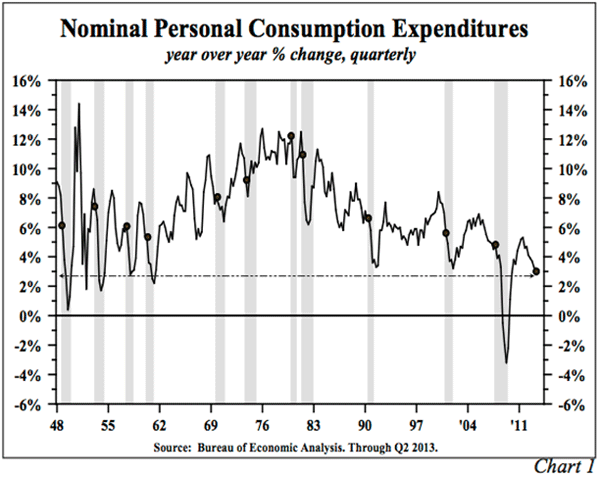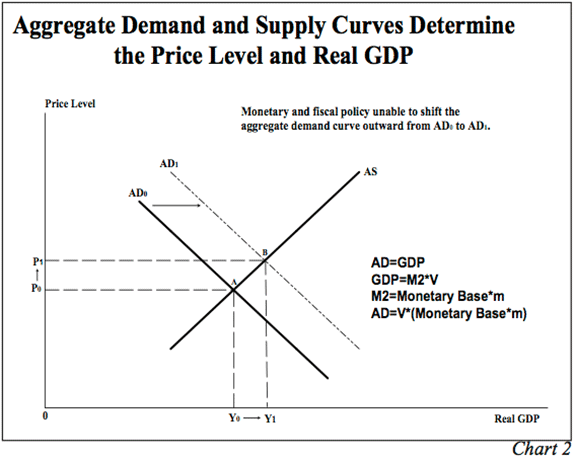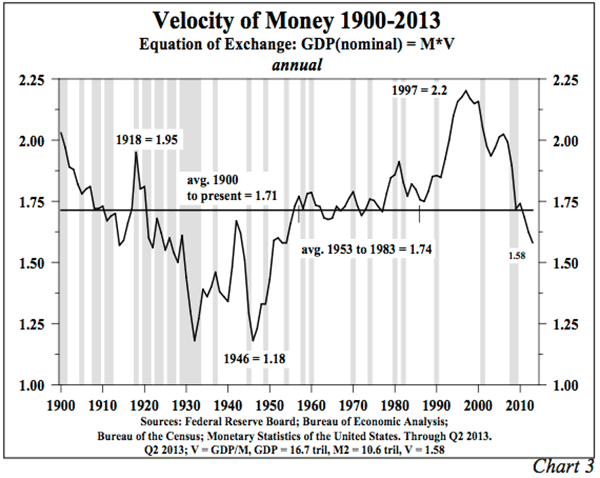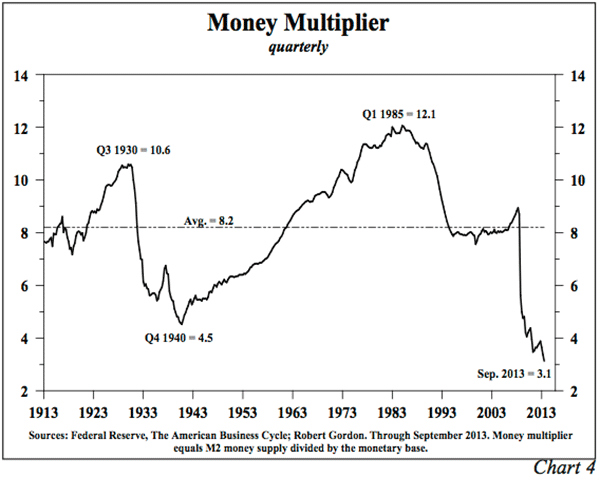Documenting the U.S. Federal Reserves Monetary and Economic Failures
Economics / US Federal Reserve Bank Oct 31, 2013 - 10:40 AM GMTBy: John_Mauldin
 In their third-quarter Review and Outlook – today's Outside the Box – Lacy Hunt and Van Hoisington get right down to telling us why the Federal Reserve's Large Scale Asset Purchase (LSAP) program is doomed to failure. (This is a thesis that is dear to my heart, since coauthor Jonathan Tepper and I explore it at length in our just-released book, Code Red.) The Fed scrambled hard and came up with some extraordinary measures to keep the global economy more or less in one piece as the Great Recession unfolded. They had to act fast, and they did; but five years down the road, with sovereign debt balloons swollen near to bursting worldwide, with markets in advanced and emerging nations alike swooning at the mere mention of the word tapering, and with the threat of a major global currency war staring us right in the face, the Fed may have just about r eached the end of its rope. But let's let Lacy and Van explain:
In their third-quarter Review and Outlook – today's Outside the Box – Lacy Hunt and Van Hoisington get right down to telling us why the Federal Reserve's Large Scale Asset Purchase (LSAP) program is doomed to failure. (This is a thesis that is dear to my heart, since coauthor Jonathan Tepper and I explore it at length in our just-released book, Code Red.) The Fed scrambled hard and came up with some extraordinary measures to keep the global economy more or less in one piece as the Great Recession unfolded. They had to act fast, and they did; but five years down the road, with sovereign debt balloons swollen near to bursting worldwide, with markets in advanced and emerging nations alike swooning at the mere mention of the word tapering, and with the threat of a major global currency war staring us right in the face, the Fed may have just about r eached the end of its rope. But let's let Lacy and Van explain:
Four considerations suggest the Fed will continue to be unsuccessful in engineering stronger growth and higher inflation with their continuation of the current program of Large Scale Asset Purchases (LSAP). First, the Fed’s forecasts have consistently been overly optimistic, indicating that their knowledge of how LSAP operates is flawed. LSAP obviously is not working in the way they had hoped, and they are unable to make needed course corrections. Second, debt levels in the U.S. are so excessive that monetary policy’s traditional transmission mechanism is defunct. Third, recent scholarly studies, all employing different rigorous analytical methods, indicate LSAP is ineffective. Fourth, declining velocity deprives the Fed of the ability to have a measurable influence on aggregate economic activity and is an alternative way of confirming the validity of the aforementioned academic studies.
As the authors explain these four problems with Fed policy and performance, you may find the discussion getting a bit, well, wonkish; but if you want the real lowdown on the limitations of central bank control of the economy (and you do), then you could hardly find a better primer than this.
Hoisington Investment Management Company (www.Hoisingtonmgt.com) is a registered investment advisor specializing in fixed-income portfolios for large institutional clients. Located in Austin, Texas, the firm has over $5 billion under management and is the sub-advisor of the Wasatch-Hoisington US Treasury Fund (WHOSX).
The launch for Code Red is going very well. We quickly rose to #1 in investing books on Amazon and are still there, which my publishers like to see. You can go to the book's website and get it at the lowest available price and watch an interview with me and my co-author, Jonathan Tepper; or you can of course find it on Amazon and iTunes. I just hope you get it and read it and find it useful. I did an interview on the book with RT.com a few weeks ago in Tucson, and it has just been released. They chose to focus on one part of the book (Japan), but we talked about other parts as well. You can see it here .
I am back in Dallas after a quick trip to see my dentist, Gary Sanchez, in Albuquerque. We had a very pleasant dinner and deep personal time last night and not so much fun today. They had to put me under to do some work on my gums, and though he is very happy with the outcome, I am still a bit drugged up, so I will just hit the send button. Have a great week!
Your glad for modern dentistry and pain meds analyst,
John Mauldin, EditorOutside the Box
JohnMauldin@2000wave.com
Hoisington Investment Management
Quarterly Review and Outlook
Third Quarter 2013
Federal Reserve Failures
The Fed's capabilities to engineer changes in economic growth and inflation are asymmetric. It has been historically documented that central bank tools are well suited to fight excess demand and rampant inflation. The Fed showed great resolve in containing the fast price increases in the aftermath of World Wars I and II and the Korean War. Later, in the late 1970s and early 1980s, rampant inflation was brought under control by a determined and persistent Federal Reserve.
However, when an economy is excessively over-indebted and disinflationary factors have forced central banks to make overnight interest rates as close to zero as possible, central bank policy has repeatedly proved powerless to further move inflation or growth metrics. The periods between 1927 and 1939 in the U.S. (and elsewhere) and from 1989 to the present in Japan are clear examples of the impotence of central bank policy actions during periods of over-indebtedness.
Four considerations suggest the Fed will continue to be unsuccessful in engineering stronger growth and higher inflation with their continuation of the current program of Large Scale Asset Purchases (LSAP). First, the Fed's forecasts have consistently been overly optimistic, indicating that their knowledge of how LSAP operates is flawed. LSAP obviously is not working in the way they had hoped, and they are unable to make needed course corrections. Second, debt levels in the U.S. are so excessive that monetary policy's traditional transmission mechanism is defunct. Third, recent scholarly studies, all employing different rigorous analytical methods, indicate LSAP is ineffective. Fourth, declining velocity deprives the Fed of the ability to have a measurable influence on aggregate economic activity and is an alternative way of confirming the validity of the aforementioned academic studies.
The Fed's Forecasts
First, if the Fed were consistently getting the economy right, then we could conclude that their understanding of current economic conditions is sound. However, if they regularly err, then it is valid to argue that they are misunderstanding the way their actions affect the economy. During the current expansion the Fed's forecasts for real GDP and inflation have been consistently above the actual outcomes. Late last year, the midpoint of the Fed's central tendency forecast projected an increase in real GDP of 2.7% for 2013. This estimate could miss the mark by nearly 50%.
One possible reason why the Fed has consistently erred on the high side in their growth forecasts is that they assume higher stock prices will lead to higher spending via the so-called wealth effect. The Fed's ad hoc analysis on this subject has been wrong and is in conflict with econometric studies. The studies suggest that when wealth rises or falls consumer spending does not generally respond, or if it does respond it does so feebly. During the run-up of stock and home prices over the past three years, the year-over- year growth in consumer spending has actually decelerated sharply from over 5% in early 2011 to just 2.9% in the four quarters ending Q2 (Chart 1). Reliance on the wealth effect played a major role in the Fed's poor economic forecasts. LSAP has not been able to spur growth and achieve the Fed's forecasts to date and certainly undermines the Fed's continued assurances that this time will truly be different.

Excessive Debt
Second, another impediment to LSAP's success is the Fed's failure to consider that excessive debt levels block the main channel of monetary influence on economic activity. Scholarly studies published in the past three years document that economic growth slows when public and private debt exceeds 260% to 275% of GDP. In the U.S., from 1870 until the late 1990s, real GDP grew by 3.7% per annum. It was during 2000 that total debt breached the 260% level. Since 2000 growth has averaged a much slower 1.8% per annum.
When total debt moved into this counterproductive zone, other far reaching and unintended consequences became evident. The standard of living, as measured by real median household income, began to stagnate and now stands at the lowest point since 1995. Additionally, since the start of the current economic expansion, real median household income has fallen 4.3%, a totally unprecedented occurrence. Moreover, both the wealth and income divides have seriously worsened. Over-indebtedness is the primary reason for slower growth, and unfortunately the Fed's activities to date have had only negative, unintended consequences.
Scholarly Studies on Large Scale Asset Purchases
The third item that points toward monetary ineffectiveness is the academic research indicating that LSAP is a losing proposition. The United States now has had five years of experience with which to evaluate the efficacy of LSAP, during which time the Fed's balance sheet has increased a record fourfold. Undeniably, the Fed has conducted an all-out effort to restore normal economic conditions. While monetary policy works with a lag, the LSAP has been in place since 2008 with no measurable benefit. This lapse of time is now far greater than even the longest of the lags measured in the extensive body of scholarly work regarding monetary policy.
Three different studies by respected academicians have independently concluded that indeed these efforts have failed. These studies, employing various approaches, have demonstrated that LSAP cannot shift the Aggregate Demand (AD) Curve (Chart 2). The AD curve intersects the Aggregate Supply Curve to determine the aggregate price level and real GDP and thus nominal GDP. The AD curve is unresponsive to monetary actions. Therefore the price level and real GDP, and thus nominal GDP, are stuck. In this circumstance, the actions of the Fed are irrelevant.

The papers we reference were presented at the Jackson Hole Monetary Conference in August 2013. The first is by Robert E. Hall, one of the world's leading econometricians and a member of the prestigious NBER Cycle Dating Committee. He wrote, "The combination of low investment and low consumption resulted in an extraordinary decline in output demand, which called for a markedly negative real interest rate, one unattainable because the zero lower bound on the nominal interest rate coupled with low inflation put a lower bound on the real rate at only a slightly negative level." Dr. Hall also wrote the following about the large increase in reserves to finance quantitative easing: "An expansion of reserves contracts the economy." In other words, not only has the Fed not improved matters, they have actually made economic conditions worse with their experimentation. Additionally, he presented evidence that forward guidance and GDP targeting both have serious problems and that central bankers should focus on requiring more capital at banks and more rigorous stress testing.
The next paper is by Hyun Song Shin, another outstanding monetary theorist and econometrician and holder of an endowed chair at Princeton University. He looked at the weighted-average effective one year rate for loans with moderate risk at all commercial banks, the effective Fed Funds rate and the spread between the two in order to evaluate Dr. Hall's study. He also evaluated comparable figures in Europe. In both the U.S. and Europe these spreads increased, supporting Hall's analysis. Dr. Shin also examined quantities such as total credit to U.S. non-financial businesses. He found that lending to non-corporate businesses, which rely on the banks, has been essentially stagnant. Dr. Shin states, "The trouble is that job creation is done most by new businesses, which tend to be small." Thus, he found "disturbing implications for the effectiveness of central bank asset purchases" and supported Hall's conclusions.
Dr. Shin argued that we should not forget how we got into this mess in the first place when he wrote, "Things were not right in the financial system before the crisis, leverage was too high, and the banking sector had become too large." For us, this insight is highly relevant since aggregate debt levels relative to GDP are greater now than in 2007. Dr. Shin, like Dr. Hall, expressed extreme doubts that forward guidance was effective in bringing down longer-term interest rates.
The last paper is by Arvind Krishnamurthy of Northwestern University and Annette Vissing- Jorgensen of the University of California, Berkeley. They uncovered evidence that the Fed's LSAP program had little "portfolio balance" impact on other interest rates and was not macro stimulus. A limited benefit did result from mortgage- backed securities purchases due to announcement effects, but even this small plus may be erased once the still unknown exit costs are included. Drs. Krishnamurthy and Vissing-Jorgensen also criticized the Fed for not having a clear policy rule or strategy for asset purchases. They argued that the absence of concrete guidance as to the goal of asset purchases, which has been vaguely defined as aimed toward substantial improvement in the outlook for the labor market, neutralizes their impact and complicates an eventual exit. Further, they wrote, "Without such a framework, investors do not know the conditions under which (asset buys) will occur or be unwound." For Krishnamurthy and Vissing-Jorgensen, this "undercuts the efficacy of policy targeted at long- term asset values."
Money Velocity
The fourth problem the Fed faces in their LSAP program is their inability to control the velocity of money. The AD curve is planned expenditures for nominal GDP. Nominal GDP is equal to the velocity of money (V) multiplied by the stock of money (M), thus GDP = M x V. This is Irving Fisher's equation of exchange, one of the important pillars of macroeconomics. V peaked in 1997, as private and public debt were quickly approaching the nonproductive zone (Chart 3). Since then V has plunged. The level of V in the second quarter is at its lowest level in six decades. By allowing high debt levels to accumulate from the 1990s until 2007, the Fed laid the foundation for rendering monetary policy ineffectual. Thus, Fisher was correct when he argued in 1933 that declining velocity would be a symptom of extreme indebtedness just as much as weak aggregate demand. Fisher was able to make this connection because he understood Eugen von Böhm-Bawerk's brilliant insight t hat debt is future consumption denied. Also, we have the benefit of Hyman Minsky's observation that debt must be able to generate an income stream to repay principal and interest, thereby explaining that there is such a thing as good (productive) debt as opposed to bad (non-productive) debt. Therefore, the decline in money velocity when there are very high levels of debt to GDP should not be surprising. Moreover, as debt levels increase so does the risk that it will be unable to generate the income stream required to pay principal and interest.

Unintended Consequences
The relentless Fed purchasing of massive amounts of securities has produced no positive economic developments but has had significant negative, unintended consequences. For example, resource allocation in the banking system can be affected. Banks have a limited amount of capital with which to take risks with their portfolio. With this capital, they have two broad options. First, they can confine their portfolio to their historical lower risk role of commercial banking operations – the making of loans and standard investments. However, with interest rates at extremely low levels the profit potential from such endeavors is minimal. Second, they can allocate resources to their proprietary trading desks to engage in leveraged financial or commodity market speculation. By their very nature these activities are potentially far more profitable, but also much riskier. Therefore, when resources are allocated to the riskier alternative in the face of limited bank capital , fewer resources are available for traditional lending. This deprives the economy of the funds needed for economic growth even though the banks may be able to temporarily improve their earnings by aggressive risk taking. Perversely, confirming the point made by Dr. Hall, a rise in stock prices generated by excess reserves may deprive, rather than supply, funds needed for economic growth.
Determining with certainty whether funds are being deprived is difficult, but a visible piece of evidence confirms that this is occurring. This factor is the unprecedented downward trend in the money multiplier. The money multiplier is the link between the monetary base (high-powered money) and the money supply (M2). The money multiplier is calculated by dividing the base into M2. Today, the monetary base is $3.5 trillion, and M2 stands at $10.8 trillion. By dividing the monetary base into M2, the money multiplier is 3.1. In 2008, prior to the Fed's massive expansion of the monetary base, the money multiplier stood at 9.3, meaning that $1 of base supported $9.30 of M2.
If reserves created by LSAP were spreading throughout the economy in the traditional manner, then the money multiplier should be more stable. However, if those reserves were essentially funding speculative activity, then reserves would remain with the large banks, and the money multiplier would fall. This is the current condition. The September 2013 level of 3.1 is the lowest in the entire 100-year history of the Federal Reserve (Chart 4). Until the last five years, the money multiplier never dropped below the old historical low of 4.5 reached in late 1940. Thus, LSAP may have produced the unintended consequence of actually reducing economic growth. Stock market investors benefited, but this did not carry through to the broader economy. The net result is that LSAP worsened the gap between high and low income households. When policy makers try untested theories, unknown risks are almost impossible to anticipate.

Interest Rates
Economic growth should be very poor in the final months of 2013. Growth is unlikely to exceed 1%, even less than the already anemic 1.6% rate of growth in the past four quarters. Marked improvement in 2014 is also questionable. Nominal interest rates have increased this year, and real yields have risen even more sharply because the inflation rate has dropped significantly. Due to the recognition and implementation lags, only half of the $275 billion 2013 tax increase will have been registered by the end of the year, with the remaining impact occurring in 2014 and 2015. Currently, many of the taxes and other cost burdens of the Affordable Care Act are in the process of being shifted from corporations and profitable small businesses to households, thus serving as a de facto tax increase. In such conditions, the broadest measures of inflation, which are barely exceeding 1%, should weaken further. Since LSAP does not constitute macro- stimulus, its continuation is equall y meaningless. Therefore, the decision of the Fed not to taper is inconsequential for the outlook for economic growth. We expect the downward trend in long- term Treasury bond yields to resurface as these weaker growth and softer inflationary conditions persist.
Van R. Hoisington
Lacy H. Hunt, Ph.D.
John Mauldin
subscribers@MauldinEconomics.com
Outside the Box is a free weekly economic e-letter by best-selling author and renowned financial expert, John Mauldin. You can learn more and get your free subscription by visiting www.JohnMauldin.com.
Please write to johnmauldin@2000wave.com to inform us of any reproductions, including when and where copy will be reproduced. You must keep the letter intact, from introduction to disclaimers. If you would like to quote brief portions only, please reference www.JohnMauldin.com.
John Mauldin, Best-Selling author and recognized financial expert, is also editor of the free Thoughts From the Frontline that goes to over 1 million readers each week. For more information on John or his FREE weekly economic letter go to: http://www.frontlinethoughts.com/
To subscribe to John Mauldin's E-Letter please click here:http://www.frontlinethoughts.com/subscribe.asp
Copyright 2013 John Mauldin. All Rights Reserved
Note: John Mauldin is the President of Millennium Wave Advisors, LLC (MWA), which is an investment advisory firm registered with multiple states. John Mauldin is a registered representative of Millennium Wave Securities, LLC, (MWS), an FINRA registered broker-dealer. MWS is also a Commodity Pool Operator (CPO) and a Commodity Trading Advisor (CTA) registered with the CFTC, as well as an Introducing Broker (IB). Millennium Wave Investments is a dba of MWA LLC and MWS LLC. Millennium Wave Investments cooperates in the consulting on and marketing of private investment offerings with other independent firms such as Altegris Investments; Absolute Return Partners, LLP; Plexus Asset Management; Fynn Capital; and Nicola Wealth Management. Funds recommended by Mauldin may pay a portion of their fees to these independent firms, who will share 1/3 of those fees with MWS and thus with Mauldin. Any views expressed herein are provided for information purposes only and should not be construed in any way as an offer, an endorsement, or inducement to invest with any CTA, fund, or program mentioned here or elsewhere. Before seeking any advisor's services or making an investment in a fund, investors must read and examine thoroughly the respective disclosure document or offering memorandum. Since these firms and Mauldin receive fees from the funds they recommend/market, they only recommend/market products with which they have been able to negotiate fee arrangements.
Opinions expressed in these reports may change without prior notice. John Mauldin and/or the staffs at Millennium Wave Advisors, LLC and InvestorsInsight Publishing, Inc. ("InvestorsInsight") may or may not have investments in any funds cited above.
Disclaimer PAST RESULTS ARE NOT INDICATIVE OF FUTURE RESULTS. THERE IS RISK OF LOSS AS WELL AS THE OPPORTUNITY FOR GAIN WHEN INVESTING IN MANAGED FUNDS. WHEN CONSIDERING ALTERNATIVE INVESTMENTS, INCLUDING HEDGE FUNDS, YOU SHOULD CONSIDER VARIOUS RISKS INCLUDING THE FACT THAT SOME PRODUCTS: OFTEN ENGAGE IN LEVERAGING AND OTHER SPECULATIVE INVESTMENT PRACTICES THAT MAY INCREASE THE RISK OF INVESTMENT LOSS, CAN BE ILLIQUID, ARE NOT REQUIRED TO PROVIDE PERIODIC PRICING OR VALUATION INFORMATION TO INVESTORS, MAY INVOLVE COMPLEX TAX STRUCTURES AND DELAYS IN DISTRIBUTING IMPORTANT TAX INFORMATION, ARE NOT SUBJECT TO THE SAME REGULATORY REQUIREMENTS AS MUTUAL FUNDS, OFTEN CHARGE HIGH FEES, AND IN MANY CASES THE UNDERLYING INVESTMENTS ARE NOT TRANSPARENT AND ARE KNOWN ONLY TO THE INVESTMENT MANAGER.
John Mauldin Archive |
© 2005-2022 http://www.MarketOracle.co.uk - The Market Oracle is a FREE Daily Financial Markets Analysis & Forecasting online publication.



